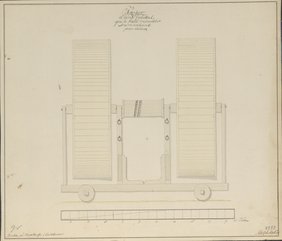The sheet with the view of a "PROJET d'une Guindal, qui se fait mouvoir en marchant par dedans" (Project of a winch that is moved by walking) is an exception within Albrecht Haupt's collection of drawings. It is the only engineering or machine drawing. It shows the view of the winch with its two treadwheels seen from its front side. The cross view needed for a full understanding of its function and also the ground plan, or the top view, have not been preserved. The winch visible in the middle is operated by a double treadwheel, as had been used for harbour cranes since the Middle Ages. Winches were used, among other things, to pull ships into the docks. The note in Swedish "Brukas på Skepswarfa i Carlskrona" (Used at the shipyard in Karlskrona) refers to the actual use at a shipyard or dock. A new feature is that the winch can be moved sideways.
Even though the design of hoisting and construction machinery or other technical structures such as mills or locks was part of the architects' field of activity until the beginning of the 19th century, this area did not correspond to Haupt's interest in collecting. The sheet came into his collection as an addition to the collection of drawings by a Swedish architect (Sign. XXIVb), who is not, however, identical with the author of the drawing. However, he added the presumed author Adolph Modéèr in his own hand at the bottom right of the sheet.
Adolph Modéèr (1739-1799) was a Swedish naturalist, economist and publicist. He became famous especially in the 1780s and 1790s for a series of important writings in the field of social sciences and political economy. He was a member of the Academy of Sciences (1786) and several other Swedish and foreign scientific societies. That he appears here as the "inventor" of a winch may be surprising at first glance, but it is not unusual. After graduating from Lund in 1754, he worked for over twenty years as a surveyor in the province of Kalmar, in the Stockholm area and in the province of Gävleborg. It is therefore obvious that he had a solid education in drawing and probably also had a basic knowledge of mechanics and physics. The drawing is therefore likely to date from these early years.
The southern Swedish port city of Karlskrona, his birthplace, founded in 1679, was one of the most important naval bases of the Swedish kingdom. Since 1998, the naval port of Karlskrona and other buildings in the city have been listed as UNESCO World Heritage Sites.
sp


